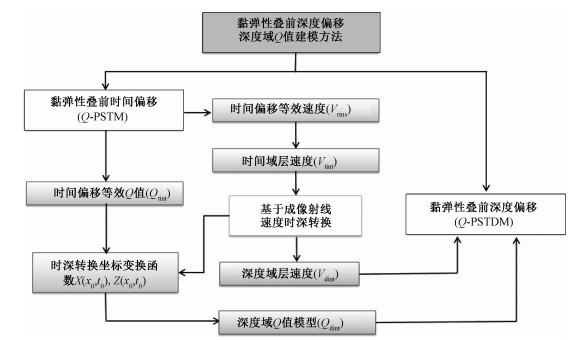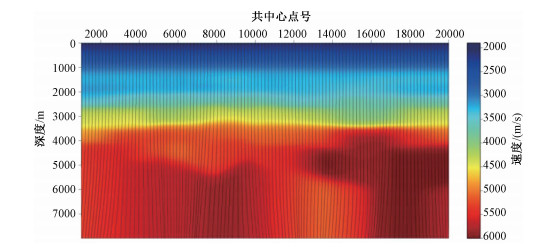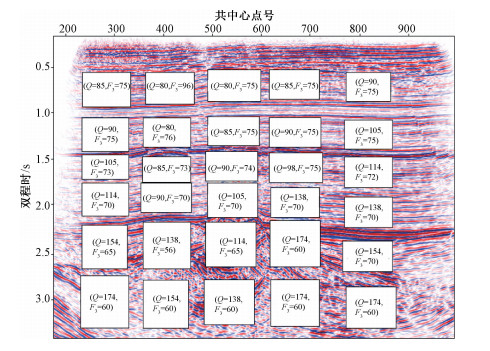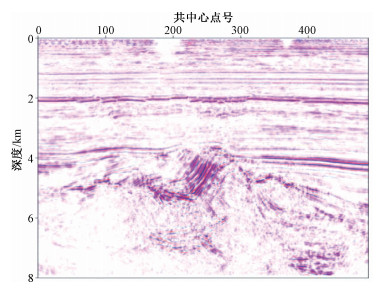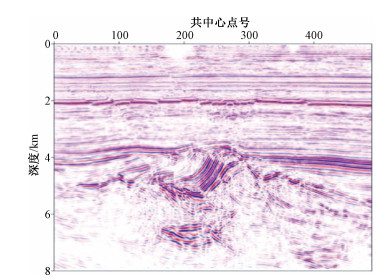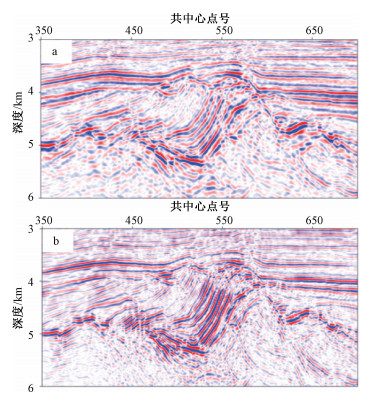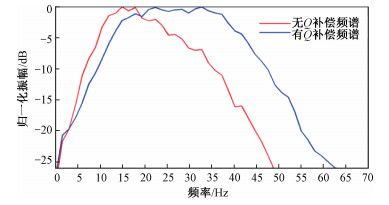Q estimation of seismic reflection data and its application in oil and gas exploration
-
摘要:
油气地震勘探中,地震波在实际介质中传播时会产生明显的吸收衰减现象,导致地震信号中的主频向低频移动,频带宽度变窄,相位发生畸变,制约了地震勘探识别薄层的分辨能力。为了获得更高分辨率的地震成像,文章介绍了一种在地震反射数据成像域进行Q值估计建模的方法与流程,并利用估计出的Q值通过偏移成像对数据进行衰减补偿,实现高分辨率成像。该方法在时间域引入等效Q值的概念,首先在初步黏弹性时间偏移成像域的时窗内,通过数据在时窗内的补偿效果来确定时间域的等效Q值参数,接着通过在深度域层速度上计算成像射线获得时深转换关系,进而对转换到时间域层Q值的等效参数进行时深转换,完成最终深度域Q值建模,最后将该关键参数作为黏弹性叠前深度偏移的输入,进行复杂构造的黏弹性补偿成像。同时使用中国东部某实际地震数据来验证方法的有效性,验证结果表明发展的流程和方法可较好实现深度域负责构造Q值建模和成像域补偿,实现复杂构造高分辨成像。
Abstract:In oil and gas seismic exploration, when the seismic wave propagates in the earth medium, it will encounter obvious absorption and attenuation, resulting in the main frequency of the seismic signal shifting to the low-frequency end. The frequency band narrows and the phase is distorted, which restricts the resolution of seismic exploration to identify thin layers. To obtain a seismic image with higher resolution, this paper introduces a method with effective Q estimation in the imaging domain of seismic reflection data and uses the estimated Q-value to compensate for the attenuation effect through migration to achieve high-resolution imaging. This method introduces the concept of effective Q-value into the time domain. In the time window of the initial viscoelastic time migration image, the effective Q parameters in the time domain are determined through the compensation effect of the data in the time window. Then, the time-depth conversion function is obtained by calculating the imaging ray in the layer velocity in the depth domain, and then the time-depth conversion is carried out for the Q parameters converted to the layer Q-value in the time domain. At last, the key parameter is used as the input of viscoelastic prestack depth migration for viscoelastic compensation imaging of complex structures. Finally, this paper uses the real seismic data from eastern China to verify the effectiveness of the method. The final results show that the process and method developed in this paper can better realize the Q-value modeling and imaging domain compensation in the depth domain, and realize the high-resolution imaging of complex structures.
-
Key words:
- Viscoelastic media /
- Q /
- Attenuation compensation /
- Time-depth conversion /
- High resolution imaging
-

-
AKI K, RICHARDS P G, 1980. Quantitative seismology[M]. San Francisco: W. H. Freeman & Co.
CAO S Y, TAN J, GAO M, et al., 2014. Seismic Q estimation with logarithmic spectrum equation root[J]. Oil Geophysical Prospecting, 49(1): 161-166. (in Chinese with English abstract)
CAUSSE E, URSIN B, 2000. Viscoacoustic reverse-time migration[J]. Journal of Seismic Exploration, 9(2): 165-183.
DUTTA G, SCHUSTER G T, 2014. Attenuation compensation for least-squares reverse time migration using the viscoacoustic-wave equation[J]. Geophysics, 79(6): S251-S262. doi: 10.1190/geo2013-0414.1
FLETCHER R P, NICHOLS D, CAVALCA M, 2012. Wavepath-consistent effective Q estimation for Q-compensated reverse-time migration[C]//74th EAGE Conference and Exhibition incorporating EUROPEC 2012. Copenhagen, Denmark: European Association of Geoscientists & Engineers.
GAO J H, YANG S L, 2007. On the method of quality factors estimation from zero-offset VSP data[J]. Chinese Journal of Geophysics, 50(4): 1198-1209. (in Chinese with English abstract)
HARGREAVES N D, CALVERT A J, 1991. Inverse Q filtering by Fourier transform[J]. Geophysics, 56(4): 519-527. doi: 10.1190/1.1443067
KJARTANSSON E, 1979. Constant Q-wave propagation and attenuation[J]. Journal of Geophysical Research: Solid Earth, 84(B9): 4737-4748. doi: 10.1029/JB084iB09p04737
LI Z C, GUO Z B, TIAN K, 2014. Least-squares reverse time migration in visco-acoustic medium[J]. Chinese Journal of Geophysics, 57(1): 214-228. (in Chinese with English abstract)
LIU G C, LI C, 2020. Velocity-independent prestack seismic Q estimation based on multi-ray joint inversion[J]. Chinese Journal of Geophysics, 63(4): 1569-1584. (in Chinese with English abstract)
LIU K, ZHAO W J, 2005. Application of seismic phase analysis in the interpretation of deep seismic reflection data[J]. Journal of Geomechanics, 11(2): 129-134. (in Chinese with English abstract)
MITTET R, SOLLIE R, HOKSTAD K, 1995. Prestack depth migration with compensation for absorption[J]. Journal of Applied Geophysics, 34(2): 141.
MITTET R, 2007. A simple design procedure for depth extrapolation operators that compensate for absorption and dispersion[J]. Geophysics, 72(2): S105-S112. doi: 10.1190/1.2431637
PANG X Q, LIN H X, ZHENG D Y, et al., 2020. Basic characteristics, dynamic mechanism and development direction of the formation and distribution of deep and ultra-deep carbonate reservoirs in China[J]. Journal of Geomechanics, 26(5): 673-695. (in Chinese with English abstract)
QUAN Y L, HARRIS J M, 1997. Seismic attenuation tomography using the frequency shift method[J]. Geophysics, 62(3): 895-905. doi: 10.1190/1.1444197
SUH S, YOON K, CAI J, et al., 2012. Compensating visco-acoustic effects in anisotropic reverse-time migration[C]//The 2012 SEG Annual Meeting. Las Vegas, Nevada: SEG: 1-5.
SUN J Z, FOMEL S, ZHU T Y, et al., 2016. Q-compensated least-squares reverse time migration using low-rank one-step wave extrapolation[J]. Geophysics, 81(4): S271-S279. doi: 10.1190/geo2015-0520.1
TAN Y L, WANG Z X, FENG X Q, et al., 2021. Structural preservation conditions analysis of oil and gas in complex structural area: A case study of structural analysis in the Well Wanjingdi-1, Anhui, China[J]. Journal of Geomechanics, 27(3): 441-452. (in Chinese with English abstract)
TRAYNIN P, LIU J, REILLY J M, 2008. Amplitude and bandwidth recovery beneath gas zones using Kirchhoff prestack depth Q-migration[C]//The 2008 SEG Annual Meeting. Las Vegas, Nevada: SEG: 2412-2416.
WANG S D, YANG D F, LI J N, et al., 2015. Q factor estimation based on the method of logarithmic spectral area difference[J]. Geophysics, 80(6): V157-V171. doi: 10.1190/geo2014-0257.1
WANG X J, YIN X Y, WU G C, 2011. Estimation of stratigraphic quality factors on pre-stack seismic data[J]. Oil Geophysical Prospecting, 46(3): 423-428. (in Chinese with English abstract)
WANG X J, YAN Z H, LIU X X, et al., 2019. The application of formation Q value compensation method based on wavelet frequency division to the exploration of middle-deep hydrocarbon in the East China Sea[J]. Marine Geology and Quaternary Geology, 39(6): 200-206. (in Chinese with English abstract)
WANG Y H, 2002. A stable and efficient approach of inverse Q filtering[J]. Geophysics, 67(2): 657-663. doi: 10.1190/1.1468627
WANG Y H, 2006. Inverse Q-filter for seismic resolution enhancement[J]. Geophysics, 71(3): V51-V60. doi: 10.1190/1.2192912
WANG Y H, 2008. Inverse-Q filtered migration[J]. Geophysics, 73(1): S1-S6. doi: 10.1190/1.2806924
WU J, CHEN X H, BAI M, et al., 2015. Attenuation compensation in multicomponent Gaussian beam prestack depth migration[J]. Applied Geophysics, 12(2): 157-168. (in Chinese with English abstract) doi: 10.1007/s11770-015-0487-z
WU X D, LIAO J, SUN W Z, et al., 2021. Natural gas distribution and reservoir-forming law of the Yinggehai Basin, China[J]. Journal of Geomechanics, 27(6): 963-974. (in Chinese with English abstract)
YAN H Y, LIU Y, 2013. Visco-acoustic prestack reverse-time migration based on the time-space domain adaptive high-order finite-difference method[J]. Geophysical Prospecting, 61(5): 941-954. doi: 10.1111/1365-2478.12046
YUAN S Y, WANG S X, TIAN N, et al., 2016. Stable inversion-based multitrace deabsorption method for spatial continuity preservation and weak signal compensation[J]. Geophysics, 81(3): V199-V212. doi: 10.1190/geo2015-0247.1
ZENG X, TIAN J X, ZHANG G Q, et al., 2018. Main Types and hydrocarbon exploration direction of the paleo-uplifts in the Qaidam Basin[J]. Journal of Geomechanics, 24(3): 381-390. (in Chinese with English abstract)
ZHANG H, XU J C, LI J B, 2016. Enhanced 3D prestack depth Imaging of broadband data from the South China Sea: A case study[J]. Exploration Geophysics, 47(3): 219-227. doi: 10.1071/EG16009
ZHANG J F, WU J Z, LI X Y, 2013. Compensation for absorption and dispersion in prestack migration: An effective Q approach[J]. Geophysics, 78(1): S1-S14. doi: 10.1190/geo2012-0128.1
ZHANG L Y, FAN K, HUANG C J, et al., 2011. Potential of the deep oil-gas reservior-forming and exploitation direction in Jizhong depression[J]. Journal of Geomechanics, 17(2): 144-157. (in Chinese with English abstract)
ZHANG Q, JI F, 2021. Geophysical characteristics of the Terror Rift, West Antarctica[J]. Journal of Geomechanics, 27(5): 809-820. (in Chinese with English abstract)
ZHAO J, GAO J H, WANG D X, et al., 2013. Estimation of quality factor Q from pre-stack CMP records[J]. Chinese Journal of Geophysics, 56(7): 2413-2428. (in Chinese with English abstract)
ZHU T Y, HARRIS J M, BIONDI B, 2014. Q-compensated reverse-time migration[J]. Geophysics, 79(3): S77-S87. doi: 10.1190/geo2013-0344.1
ZOU P, CHENG J B, 2020. Visco-acoustic wave equation reflection inversion for the Q model[J]. Chinese Jounral of Geophysics, 63(1): 287-297. (in Chinese with English abstract)
曹思远, 谭佳, 高明, 等, 2014. 对数谱根式法Q值反演[J]. 石油地球物理勘探, 49(1): 161-166. https://www.cnki.com.cn/Article/CJFDTOTAL-SYDQ201401023.htm
高静怀, 杨森林, 2007. 利用零偏移VSP资料估计介质品质因子方法研究[J]. 地球物理学报, 50(4): 1198-1209. https://www.cnki.com.cn/Article/CJFDTOTAL-DQWX200704030.htm
李振春, 郭振波, 田坤, 2014. 黏声介质最小平方逆时偏移[J]. 地球物理学报, 57(1): 214-228. https://www.cnki.com.cn/Article/CJFDTOTAL-DQWX201401018.htm
刘国昌, 李超, 2020. 基于多射线联合反演的速度无关叠前地震数据Q值估计[J]. 地球物理学报, 63(4): 1569-1584. https://www.cnki.com.cn/Article/CJFDTOTAL-DQWX202004024.htm
刘葵, 赵文津, 2005. 地震相分析在深反射地震勘探资料解释中的应用[J]. 地质力学学报, 11(2): 129-134. doi: 10.3969/j.issn.1006-6616.2005.02.004 https://journal.geomech.ac.cn/article/id/2085370a-5613-42e5-bcb8-6b76be5d4763
庞雄奇, 林会喜, 郑定业, 等, 2020. 中国深层和超深层碳酸盐岩油气藏形成分布的基本特征与动力机制及发展方向[J]. 地质力学学报, 26(5): 673-695. https://journal.geomech.ac.cn/cn/article/doi/10.12090/j.issn.1006-6616.2020.26.05.057
谭元隆, 王宗秀, 冯兴强, 等, 2021. 复杂构造区油气构造保存条件分析: 来自皖泾地1井的构造解析[J]. 地质力学学报, 27(3): 441-452. https://journal.geomech.ac.cn/cn/article/doi/10.12090/j.issn.1006-6616.2021.27.03.040
王小杰, 印兴耀, 吴国忱, 2011. 基于叠前地震数据的地层Q值估计[J]. 石油地球物理勘探, 46(3): 423-428. https://www.cnki.com.cn/Article/CJFDTOTAL-SYDQ201103016.htm
王小杰, 颜中辉, 刘欣欣, 等, 2019. 基于小波分频的Q值补偿技术在东海中深层油气勘探中的应用[J]. 海洋地质与第四纪地质, 39(6): 200-206. https://www.cnki.com.cn/Article/CJFDTOTAL-HYDZ201906018.htm
吴娟, 陈小宏, 白敏, 等, 2015. 基于吸收衰减补偿的多分量高斯束叠前深度偏移(英文)[J]. 应用地球物理, 12(2): 157-168. https://www.cnki.com.cn/Article/CJFDTOTAL-CAGJ201502005.htm
吴迅达, 廖晋, 孙文钊, 等, 2021. 莺歌海盆地天然气运聚成藏条件与分布富集规律[J]. 地质力学学报, 27(6): 963-974. https://journal.geomech.ac.cn/cn/article/doi/10.12090/j.issn.1006-6616.2021.27.06.078
曾旭, 田继先, 张国卿, 等, 2018. 柴达木盆地古隆起主要类型及油气勘探方向[J]. 地质力学学报, 24(3): 381-390. https://journal.geomech.ac.cn/cn/article/doi/10.12090/j.issn.1006-6616.2018.24.03.039
张林炎, 范昆, 黄臣军, 等, 2011. 冀中坳陷深层油气成藏潜力与勘探方向[J]. 地质力学学报, 17(2): 144-157. https://journal.geomech.ac.cn/article/id/7ded73e6-60de-44df-9f0e-c981f074f691
张峤, 纪飞, 2021. 西南极特拉裂谷综合地球物理特征分析[J]. 地质力学学报, 27(5): 809-820. https://journal.geomech.ac.cn/cn/article/doi/10.12090/j.issn.1006-6616.2021.27.05.066
赵静, 高静怀, 王大兴, 等, 2013. 利用叠前CMP资料估计介质品质因子[J]. 地球物理学报, 56(7): 2413-2428. https://www.cnki.com.cn/Article/CJFDTOTAL-DQWX201307026.htm
邹鹏, 程玖兵. 2020. 黏声方程Q值反射波反演[J]. 地球物理学报, 63(1): 287-29. https://www.cnki.com.cn/Article/CJFDTOTAL-DQWX202001033.htm
-



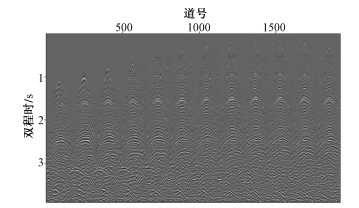
 下载:
下载:
